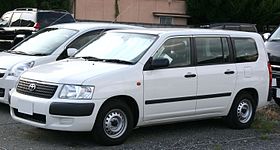Toyota Succeed: Difference between revisions
Appearance
Content deleted Content added
m →External links: Task 15: language icon template(s) replaced (2×); |
|||
| Line 53: | Line 53: | ||
[[Category:Crossover sport utility vehicles]] |
[[Category:Crossover sport utility vehicles]] |
||
[[Category:Cars introduced in 2002]] |
[[Category:Cars introduced in 2002]] |
||
[[Category:2000s cars]] |
|||
[[Category:2010s cars]] |
[[Category:2010s cars]] |
||
Revision as of 04:33, 2 January 2020
This article needs additional citations for verification. (May 2016) |
You can help expand this article with text translated from the corresponding article in Japanese. (September 2012) Click [show] for important translation instructions.
|
| Toyota Succeed (XP50/XP160) | |
|---|---|
 | |
| Overview | |
| Manufacturer | Toyota |
| Production | 2002–present |
| Assembly | Ōyamazaki, Kyoto, Japan (Daihatsu) |
| Body and chassis | |
| Class | Light Commercial Vehicle |
| Body style | 5-door wagon |
| Layout | |
| Platform | Toyota NBC platform |
| Related | Toyota Probox (XP50) |
| Powertrain | |
| Engine | |
| Transmission | |
| Dimensions | |
| Wheelbase | 2,550 mm (100.4 in) |
| Length | 4,300 mm (169.3 in) |
| Width | 1,690–1,695 mm (66.5–66.7 in) |
| Height | 1,510 mm (59.4 in) (FWD) 1,515 mm (59.6 in) (4WD) |
| Curb weight | 1,050 kg - 1,140 kg |
| Chronology | |
| Predecessor | Toyota Caldina van (T190) |
The Toyota Succeed is a station wagon sold by Toyota in Japan as a passenger car.[1][2] It was introduced in July 2002. A more basic version for delivery use is known as the Toyota Probox.
For 2007 Japanese models, G-Book, a subscription telematics service, was offered as an option.
The 2014 model of the Succeed had an interior and exterior facelift, the new model also bears a strong resemblance to the current model of the Toyota Probox.

References
- ^ Succeed wagon Archived 2007-02-22 at the Wayback Machine
- ^ Succeed van Archived 2007-02-22 at the Wayback Machine
External links
- Succeed wagon (in Japanese)
- Succeed Van (in Japanese)
